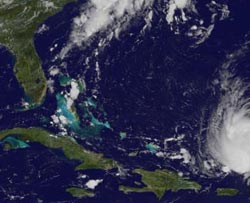NASA keeping an eye on Dorian's remnants

NOAA's GOES-13 satellite captured this image of Dorian's remnants (far right) located north of Puerto Rico on July 29 at 10:45 a.m. EDT.<br><br>Credit: NASA GOES Project<br>
NASA and NOAA satellites continue to keep a close eye on the remnants of Tropical Storm Dorian as they make their way through the eastern Caribbean Sea.
On Saturday, July 27 at 11 a.m. EDT, Dorian was still a tropical storm, but that didn't last. Dorian was near 18.5N and 52.1W, about 720 miles (1,160 km) east of the Northern Leeward Islands. Dorian's maximum sustained winds were near 40 mph (65 kph) and it was moving to the west at 23 mph (37 kph).
By July 28, Dorian weakened to a remnant low pressure area. It was producing showers and thunderstorms that extended a few hundred miles northeast of the Northern Leeward Islands. Dorian's remnants passed north of the Leeward Islands on July 28.
On Monday, July 29, remnants of Doran and a trough (elongated area) of low pressure were generating disorganized clouds and thunderstorms a couple of hundred miles north of Puerto Rico. Those clouds were seen by NOAA's GOES-13 satellite. The GOES-13 satellite image captured on July 29 at 14:45 UTC (10:45 a.m. EDT) shows that Dorian seems to have regained a more rounded appearance. However, the National Hurricane Center noted that the disturbance still does not appear to have a closed low-level circulation and surface pressures remain high across the area. If pressure drops, it would be a sign that the low pressure area is consolidating, but that was not occurring during the morning of July 29.
GOES satellites are managed and operated by NOAA, and the GOES image was created by NASA's GOES Project at the NASA Goddard Space Flight Center in Greenbelt, Md.
Environmental conditions are expected to be only marginally conducive for regeneration to occur, and the National Hurricane Center gives Dorian's remnants a medium chance, about 40 percent of becoming a tropical cyclone again. The remnant low is moving to the west and is expected to move to the west-northwest in the next two days. As it continues moving it is expected to move across the Turks and Caicos Islands and the Bahamas on Tuesday and Wednesday, July 30 and 31.
Media Contact
More Information:
http://www.nasa.govAll latest news from the category: Earth Sciences
Earth Sciences (also referred to as Geosciences), which deals with basic issues surrounding our planet, plays a vital role in the area of energy and raw materials supply.
Earth Sciences comprises subjects such as geology, geography, geological informatics, paleontology, mineralogy, petrography, crystallography, geophysics, geodesy, glaciology, cartography, photogrammetry, meteorology and seismology, early-warning systems, earthquake research and polar research.
Newest articles

Trotting robots reveal emergence of animal gait transitions
A four-legged robot trained with machine learning by EPFL researchers has learned to avoid falls by spontaneously switching between walking, trotting, and pronking – a milestone for roboticists as well…

Innovation promises to prevent power pole-top fires
Engineers in Australia have found a new way to make power-pole insulators resistant to fire and electrical sparking, promising to prevent dangerous pole-top fires and reduce blackouts. Pole-top fires pose…

Possible alternative to antibiotics produced by bacteria
Antibacterial substance from staphylococci discovered with new mechanism of action against natural competitors. Many bacteria produce substances to gain an advantage over competitors in their highly competitive natural environment. Researchers…





















